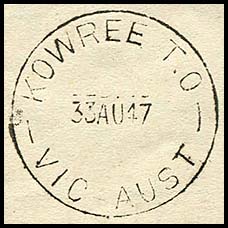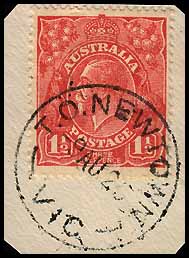Telegraph Offices on the Narracoorte line (No. 3 West).
- Australia 1901-1988
- New South Wales
- Overview of NSW
- Telegraph lines
- Telegraph Offices
- Date stamps
- Forms
- Envelopes
- Instructional annotation
- Collect
- Delayed
- Free
- Immediate Urgent
- Reply paid
- Rates
- Stamps
- 1871 Telegraph stamps
- 1885 proposal
- 1893 proposal
- Queensland
- South Australia
- Tasmania
- Victoria
- Western Australia
- International
- Special aspects
The Post and Telegraph Offices on the Narracoorte line (No. 3 West) are included together with those on the associated branch lines.
The Telegraph Offices which are discussed on this page are:
| Apsley | Balmoral | Cavendish | Dunkeld | Edenhope | |
| Fiery Creek | Glenthompson | Harrow | Kowree | Lake Bolac | Linton |
| Lyons | Macarthur | Newton-Scarsdale | Piggoreet | Rokewood | Scarsdale |
| Skipton | Smythesdale | Streatham |
|
The Telegraph Office opened on 30 August 1882.
|
| Balmoral. The Telegraph Office opened in October 1875. |
|
|
|
The office was issued with a rubber double oval Post & Telegraph Office (RO3-P&TO) date stamp.
|
||
|
 26 March 1931. |
|
|
The Telegraph Office opened in January 1885. A Post Office had opened on 1 April 1853. No special date stamp for use with Telegraphs was issued to the office. |
|
The Telegraph Office opened at Dunkeld on A Telegraph Office also opened at the Railway station about 1910. That Office closed about 1916. |
|
|
The Telegraph Office opened on 30 August 1882. A Telegraph Office was also opened at the Railway Station about 1910. It was reclassified as a Post Office in 1915 and closed in the following year. |
|
Fiery Creek. Tenders were let in December 1857 for the erection of the Telegraph Office at Fiery Creek to Edmonds and Dawson for £515 3s. There were two Fiery Creek stations - renamed to Raglans and Streatham. |
|
The Telegraph Office opened on 12 July 1875 under the charge of Mr. Brent of the Melbourne Telegraph Office. Harrow is one of the earliest inland settlements in Victoria. |
||
The Office was issued with a 1 hole Belt & Buckle date stamp.
|
 25 July 1884. |
 2? July 1884. |
|
A Telegraph Office was opened when Maryvale was renamed on 1 January 1917. The Maryvale Telegraph Office had been opened in August 1911. The Kowree Telegraph Office was closed on 30 November 1954. |
|
Manufacturer's proof: 33 August 1947. |
 33 (?) August 1947. |
|
No special date stamp for use with Telegraphs was issued to the office. |
|
The Telegraph Office opened on 22 October 1868. Prior to 1860, the township had been known as Linton's. In the Ballarat Star of 7 July 1868, there had been a report that the Chief Secretary's Office had replied to the effect an office for a Telegraph at Linton, together with the necessary instruments, was ready and the arrangements would be completed as soon as funds could be provided for the purpose. On 17 October, the Star reported "Our local correspondent writes:"It appears that telegraphic communication between Linton and Smythesdale is going to be started forthwith, as the department has a man at present at Linton getting the wires in order". Finally, on 23 October, the Star reported "J. B. Scurfield, who has been placed in charge of the Linton Telegraph Office, had the apparatus in full play on Thursday (22nd) and transmitted and received some messages. A few of the residents sent messages to their acquaintances merely for the purpose of showing them that the wires are now in perfect working order". A few year later, the Ballarat Star of 23 January 1875 published the following letter to the Editor: SIR, In your issue of the 20th instant, there appeared a letter from Mr Harrison, Scarsdale, complaining of the inefficiency of the telegraphic arrangements at Linton. Sir, as a business resident and as one to whom the use o£ the wire is o£ great advantage, I cannot but feel indebted to Mr Harrison for commenting on the absurd management of this branch. Though for many years a resident of this place, I may say that I have never been put to such a degree of inconvenience as that which I have experienced since the advent of the new telegraph mistress. Confident that towards Mr Harrison, I only echo the feelings of the Linton community and apologising for trespassing on your space, I am. P.Q. Hostile reaction was swift - on 26 January, the same newspaper published two articles in strong support of the Postmistress. One of these was: Referring to a letter in this day's Star, purporting to be written by a business resident at Linton reflecting injuriously on the management of the Telegraph Office here since the advent of the new telegraph mistress and claiming to echo the feelings of the Linton community in this matter, we the undersigned residents, having constant business in connection with the Telegraph Office, desire to express our entire dissent from the statements contained in such letter and, on the contrary, to state that we have always had our business transacted punctually and satisfactorily by the present telegraph mistress whom we have at all times found courteous, attentive and obliging. We cannot but regret that an insinuation of so grave a character affecting a public servant should have been made by a writer who, while claiming to speak for the public, lacks courage to append his own signature to his letter: |
| Piggoreet. (Rokewood Branch) The Telegraph Office opened in March 1875. |
|
The Telegraph Office opened on 16 September 1873. Several good nuggets of gold found at Rokewood. During the last week of August 1873, over 100 ozs of gold were obtained by one party (Elders) and a sketch of another nugget weighing 63 ozs 17 dwt was sent to the Mining Department in Melbourne. In September 1889 several nuggets were found not more than 8 inches under the surface weighing between 5dwt and 48 ozs. The Geelong Advertiser of 8 January 1874 reported the following grievance about Rokewood: "The blunders that are sometimes made in the Telegraph department are very annoying and we trust the following will be strictly enquired into. We had made every arrangement to have the result of the trial of Dr. Cooper at Rokewood, telegraphed on Tuesday night and were very much surprised when the wire brought us no information. Yesterday we received a letter from our correspondent stating he had handed a telegram into the office for us at 6 p.m. on Tuesday. The message left at 7.55 p.m.via Smythesdale but was never sent on to Geelong until the following day. If this is the manner in which the Telegraph Department, which costs the country so much, is going to manage its business, it will be advisable to return to the old system of sending messages by carrier-pigeons. It is not the first time the officials at Rokewood have shown their incompetency and, as we have paid for a telegram which is comparatively useless, we have, we think, a right to ask Mr Turner to enquire into the matter strictly". The Colac Herald of 26 April 1895 reported this amazing account: On Good Friday (writes the Corindhap correspondent of the Ballarat Courier) a somewhat peculiar accident but fortunately attended by no serious consequence, happened at Rokewood. A large telegraph pole which stood almost in front of the Rokewood Post and Telegraph Office and store fell and crashed through the verandah of the office. It is stated that the cause of the accident was a goose while, in trying to fly over the line, came in contact with the wire about the centre of the space between the two poles - causing the pole in front of the post office to fall, it being rotten at the foot. Mr.Evans was standing on the verandah just before the fall took place, and narrowly escaped injury. Since the shooting of wild turkeys was prohibited, we have heard frequently of turkeys meeting with sudden deaths by flying against telegraph wires but this is the first time we ever heard of a goose knocking over a telegraph pole. It would be interesting to have authentic dimensions of this destructive bird. Mr Daly will see, perhaps, that it is possible for a rotten pole to do an immense amount of damage, whether it is knocked over by an elephant or a tomtit. The account of the incident is not complete, for history has not yet recorded what happened to the goose - whether it subsided into a quiet life again, or is still charging down on telegraph wires, or has been eaten as a deodand for the damage it did". The Ballarat Star of 4 July 1896 reported that the residents of Rokewood held a public meeting to |
|
The Telegraph Office opened in September 1876. |
|
In 1858, Snake Valley had a population of 2,304. In 1880, the Postmaster was R. Haworth on a salary of £36 per annum. There was no telegraphic activity and no indication of how many postal articles were handled. The Post Office issued 133 Money Orders and paid for 144. There were 11 Savings Accounts at the beginning of the year and 15 at the end of 1880. A Telegraph Office opened in December 1883. In 1884, Snake Valley had a Post Mistress and a Messenger and handled 13,780 letters posted and transmitted 493 telegraph messages (with revenue for the year from these messages of £29 19s 9d or an average per message of nearly 1s 3d - so about 12 words). Money Orders issued had risen to 226 and 150 were paid. Before the serious search for gold was extended to the Snake Valley region, there were almost no references in the press to Snake Valley in any regard. Perhaps the biggest reference appeared in the Ovens and Murray Advertiser of 2 April 1858:
|







